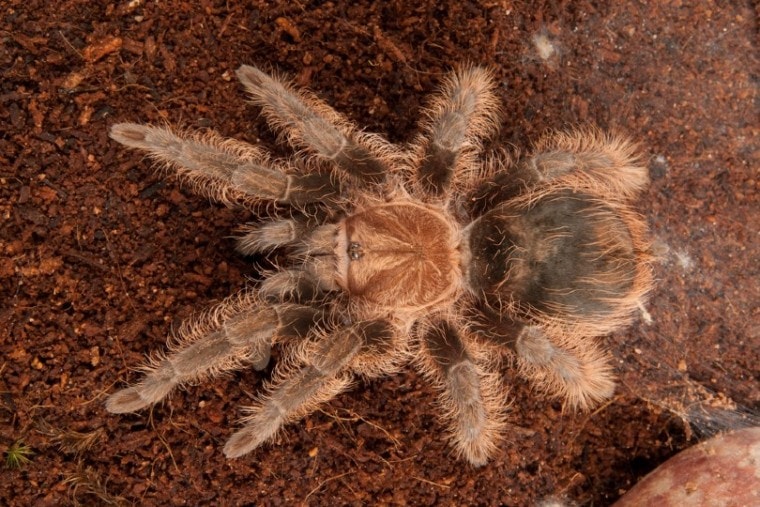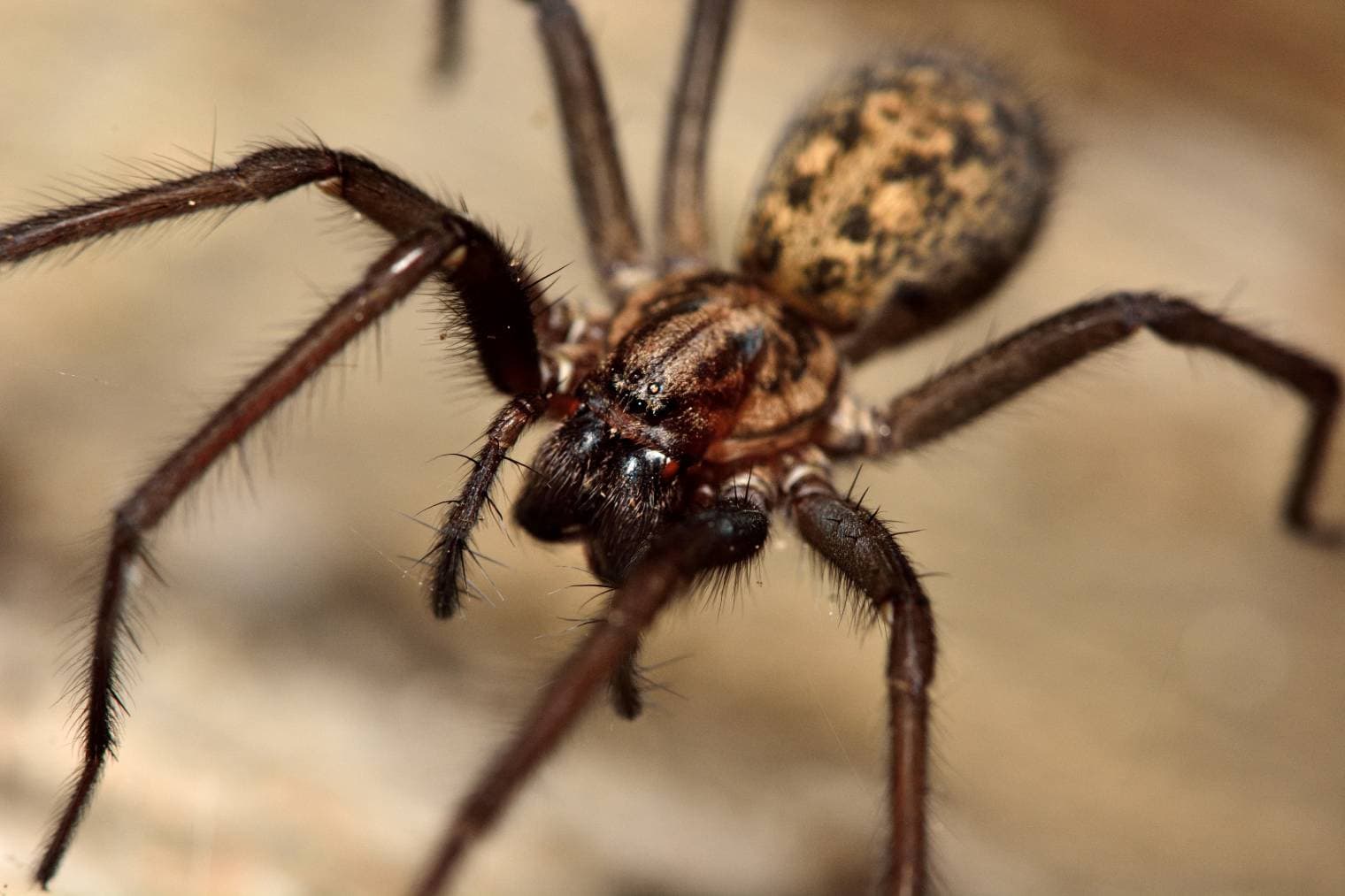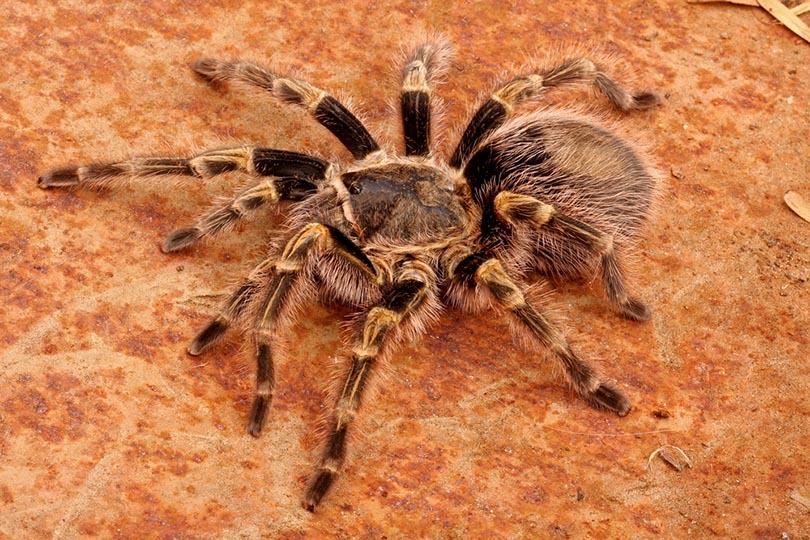
If you’ve ever considered owning a spider, there’s a good chance that you’ve already encountered the Honduran Curly Hair Tarantula. They’re a great starter pet for those dipping a toe into the world of arachnid ownership.
However, that doesn’t mean you can just pick one up from the pet store and hit the ground running without doing any research. You’ll need to learn how to take care of one before you bring it home, as you don’t want to have to figure things out on the fly.
This guide will fill you in on everything that you need to know about these fuzzy spiders, so you can keep yours alive and happy for as long as possible.
Quick Facts about Honduran Curly Hair Tarantula
| Species Name: | Tliltocatl albopilosum (formerly Brachypelma albopilosum) |
| Family: | Theraphosidae Thorell |
| Care Level: | Easy |
| Temperature: | 75 – 80°F |
| Temperament: | Calm, docile, shy |
| Color Form: | Dark brown to black, sometimes golden |
| Lifespan: | 8 – 10 years (females), 4 years (males) |
| Size: | 5.5 inches |
| Diet: | Crickets, mealworms, cockroaches |
| Minimum Tank Size: | 5 gallons |
| Tank Set-Up: | Minimal |
| Compatibility: | Poor |
Honduran Curly Hair Tarantula Overview
The Honduran Curly Hair Tarantula is one of the easier exotic pets to own, which is why many people buy one before moving on to rarer animals or insects.
Despite how easy they are to care for, owning a tarantula can be an extremely fun and rewarding experience. They tend to be shy when they’re younger, but once they warm up to you, they can be quite engaging and charming (at least insofar as a spider can be charming).
They’re also relatively hardy, so if you’re worried about accidentally killing your new pet, this spider will give you a great deal of leeway. That’s not to say that you can neglect them, of course, but they won’t drop dead at the first mistake that you make.
They don’t need much in terms of gear, and after a small initial outlay, they can be quite inexpensive to care for. They’re hands-off as well, making them an excellent choice for busy people who still want to own a pet.
However, if you’re expecting a pet that provides non-stop entertainment, then this spider won’t live up to your lofty expectations. They spend most of their time chilling underground, and they spend long periods of time just sitting there. While they provide quite a bit of fun at meal times and certain other moments, for the most part, this is a very mellow animal.
How Much Do Honduran Curly Hair Tarantula Cost?
Given the species’ popularity, you can find a Honduran Curly Hair Tarantula at any number of places, including most regular pet stores. This helps drive down the cost of buying one, and you shouldn’t expect to pay more than $20 to $50 for one.
Unless you already have all the necessary gear to house one of these spiders, though, you’ll need to buy a tank and a few accessories as well. The total for these can cost anywhere from $50 to $200, depending on what you buy.
Fortunately, the gear is a one-time expense, so once that’s purchased, all you’ll need to worry about is buying crickets and other food for your tarantula as needed.
Typical Behavior & Temperament
These tarantulas tend to be laidback, especially once they’ve fully matured. Juvenile tarantulas are a bit more skittish and prone to hide, but once they become comfortable around you, they’ll be happy to stick around and let you take a gander at them.
You shouldn’t make any sudden moves around them, though, as they’re quite easily frightened. If you handle them (which isn’t advisable because dropping them can kill them and their hairs can irritate your skin), then be careful to stay calm and move carefully.
They’re not prone to biting, but they will if they feel the need to defend themselves. Most people will only suffer pain and a bit of swelling, much like the sting of a wasp or bee. Some people are allergic, though, so if you have trouble breathing after getting bit, see a doctor immediately.
Appearance & Varieties
The Honduran Curly Hair Tarantula has a plump, round body that’s covered in small bristles. The bristles usually start off on the lighter side when the spider is young, but they tend to darken as the animal ages. Males often stay lighter than females.
The hair is especially dense on their legs, which can grow to be about 6 inches in length. As you might expect, given their name, the hair tends to curl as it grows. This can give them a fluffy appearance over time.
They also have urticating hairs that they can flick at predators if feeling threatened. Unlike many other tarantula species, though, they’re slow to fire these things off, so you shouldn’t have to worry about catching one in the eye.
While they’re medium-sized spiders, they grow slowly, and it can take several years for them to reach their full size (females may not get there until they turn 5). Females tend to be larger than males at all stages of their lifespan.
How to Take Care of Honduran Curly Hair Tarantula
Habitat, Tank Conditions & Setup
Tank
These tarantulas need at least a 5-gallon tank, although 10 gallons is preferable. It needs to be at least three times the width of the spider’s body.
These spiders love to burrow, so the tank needs to have a fair bit of depth to it, as they generally need at least 3 inches of substrate.
They don’t climb much, so there’s not a great need to take advantage of vertical space. That means you don’t need decorations like trees or sticks for them to climb, although they will appreciate having hollow logs or similar things to hide in.
The top of the cage needs to have a mesh lid, as air needs to circulate.
Bedding
These spiders need a substrate that allows them to burrow. Peat moss, chemical-free potting soil, coconut husk bedding, and vermiculite are all excellent options.
You need to provide hiding spots for them, along with burrowing material, as they need a place to retreat to when they feel threatened. Hollow logs are good choices, as are bits of bark or small clay pots.
Temperature
The tank should be kept between 75°F and 80°F at all times. You should achieve those temperatures using a heating pad or other artificial means, as the enclosure should be kept out of direct sunlight.
The humidity levels are also important. Aim for 65 to 70% humidity, and if the tank starts to get a little dry, you can use a spray bottle to mist everything down. Don’t spray the spider, though, as this can irritate them and will often cause them to try to scramble out of the cage.
Be careful, though, as all that moisture can lead to mold growth. If you spot any mold or mildew inside the tank, clean it immediately and replace all the bedding. Be sure to clean any decorations as well, and don’t use any cleaning supplies that could be toxic to your spider.
Lighting
There is no need to provide special lighting for these spiders. However, they do require a day/night cycle, so you’ll have to replicate that somehow if you keep them in a room without natural lighting.
Do Honduran Curly Hair Tarantula Get Along With Other Pets?
These spiders are solitary creatures (except when mating), so don’t expect them to get along with any other animals. You should only keep one Honduran Curly Hair Tarantula in a cage at a time, unless you’re trying to breed a male and female.
If you decide to take your spider out of their cage, be sure not to let them get too close to dogs, cats, or other pets. Their bite could cause issues for other pets, but it is much more likely that a cat or dog will kill or severely injure the spider than the other way around.
What to Feed Your Honduran Curly Hair Tarantula
These spiders primarily eat insects, and crickets, roaches, and mealworms are likely to be the easiest food for you to find. You’ll want to make sure that any insects that you feed these tarantulas have been gut-loaded, which means that they’ve been fed vitamins and minerals that are essential for the health of the spider.
Juvenile tarantulas should be fed every 2 days or so, while fully-mature spiders should only be served once a week. They prefer to hunt at night, so you should reserve feeding time for the evenings.
The tarantulas prefer to lie in wait and attack their prey from their burrows, so if they don’t have plenty of substrate to dig into, they may not eat. You can’t overfeed them at one time, as they’ll simply stop eating when full, so feel free to dump a few insects in there at once.
Be sure to remove any uneaten food after 24 hours, as the insects can contaminate the tank and even possibly injure the tarantula.
While these spiders will get most of the moisture that they need from their prey, it is a good idea to keep a shallow water dish on hand as well. Swap out the water frequently, and make sure that your spider can climb out if they fall in.
Keeping Your Honduran Curly Hair Tarantula Healthy
Honduran Curly Hair Tarantulas are a hardy species, so they aren’t likely to suffer many health issues. They may well stay healthy for the entirety of their lifespan, in fact.
Many health issues are caused by neglect on the part of their owners. If you keep the cage clean and don’t stress them out, they’ll likely stay happy and healthy for quite some time.
A sick spider will become lethargic and refuse to eat. However, this is also how they behave when they’re about to molt, so you may want to wait to see if they shed their skin before you try to track down a tarantula doctor.
The problem with having a sick tarantula is that many vets will have no idea how to help you. In many cases, all you can do is wait and see if your spider will recover.
This may be of cold comfort to you if you’ve become attached, of course, so it may be smart to track down someone knowledgeable about tarantula health well before your spider shows any signs of illness.
Breeding
Many people don’t bother trying to breed these tarantulas, as they’re fairly ubiquitous due to the massive commercial breeding operations that have already been established.
Breeding is also only recommended for experts, as Honduran Curly Hair Tarantulas can be hard to distinguish from other species in the Brachypelma genus.
If you’re hoping to make your own spiderlings, though, you shouldn’t find it to be too difficult. As long as the spiders are well cared for ahead of time, nature should be able to find its way quite easily.
Be sure to wait at least 4-6 weeks after the female has molted, as the eggs will not fertilize if she molts between mating and the cocoon stage.
If the pairing is successful, the female will make a cocoon 1 to 3 months after mating. You can remove this cocoon 4 to 5 weeks later, storing it in a secure location with 80-90% humidity and a temperature of 75°F to 82°F.
When the eggs hatch, you should have between 300 and 800 spiderlings — so make sure the lid is on the enclosure tightly.

Are Honduran Curly Hair Tarantula Suitable for You?
In addition to being beautiful and quite interesting to watch, Honduran Curly Hair Tarantulas are fun and rewarding to own. It doesn’t take much skill or effort to keep one alive, so they are a great place to start if you hope to move deeper into the world of spider ownership.
Don’t go into this thinking that you’re going to get a thrilling pet, though. These spiders spend most of their time hanging around in their burrows or otherwise being fairly inactive.
All in all, the Honduran Curly Hair Tarantula is an excellent option for anyone who wants an unorthodox pet. They may be as fluffy as a cat or dog, but they’re not quite as cuddly — although they will keep any crickets from attacking you in the middle of the night.
Featured Image Credit: Linn Currie, Shutterstock







